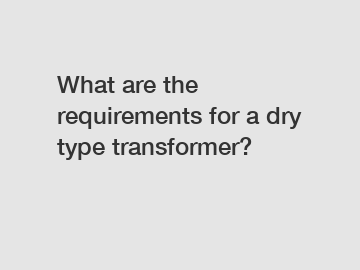Feb. 09, 2024
Electrical Equipment
Welcome to our blog, where we delve into the fascinating world of electrical transformers. Today, we will explore the key requirements for dry type transformers. These innovative devices have gained significant popularity due to their enhanced safety features, improved efficiency, and environmental friendliness. Whether you are an electrical engineer, a business owner, or an enthusiast seeking knowledge, understanding the essential prerequisites for dry type transformers is crucial. So, let's dive right in!
1. Enhanced Safety Measures.
One of the primary requirements for any transformer, especially a dry type transformer, is prioritizing safety. As dry type transformers do not use flammable liquids for cooling, they eliminate the risk of hazardous leaks or fires. When selecting a dry type transformer, look for certifications such as UL and CSA, ensuring compliance with stringent safety standards. Additionally, features like thermal protection, overcurrent protection, and short-circuit protection enhance the transformer's operational safety.

2. Environmental Considerations.
With the world increasingly focused on sustainability, dry type transformers provide a greener alternative to their oil-filled counterparts. They help reduce the risk of soil and groundwater contamination by eliminating the need for insulating oil. Look for transformers with low energy losses, high energy efficiency ratings (typically above 95%), and compliance with environmental regulations such as RoHS (Restriction of Hazardous Substances). Investing in an eco-friendly solution will not only benefit the environment but also contribute to your organization's corporate social responsibility.
3. Thermal Management.
Efficient thermal management is a critical requirement for dry type transformers. Since these transformers rely on air to dissipate heat, proper cooling measures must be in place to prevent overheating and ensure optimal performance. Features such as ventilated enclosures, adequate spacing for airflow, and efficient cooling fans are essential considerations. Heat-resistant materials, like high-grade insulation systems, also contribute significantly to the transformer's thermal stability, enabling it to operate reliably in diverse environments.
4. Insulation Material and Design.
Choosing the right insulation material and design is crucial for dry type transformers. High-quality insulation ensures excellent dielectric strength, which is especially important in challenging conditions such as high humidity or high altitude. Common insulation materials include epoxy resin, polyester resin, and polyurethane resin. Additionally, transformers designed with optimal winding configurations reduce hotspots and enhance overall performance. Seek transformers where insulation systems are designed and manufactured using advanced techniques for reliable and durable operation.
5. Noise and Vibrations.
Unwanted noise and vibrations from transformers can be quite disruptive, particularly in residential or office spaces. Dry type transformers, with their solid-core technology, provide a solution with significantly reduced noise levels. When choosing a transformer, consider acoustic insulation within the enclosure and check if it complies with noise emission standards, such as NEMA ST-20.
6. Maintenance and Longevity.
Low maintenance requirements are another critical aspect to consider when selecting a dry type transformer. Since these transformers do not use oil, there is no need for regular oil testing, maintenance, or oil replacement. However, routine inspections and cleaning to prevent dust accumulation are still recommended. Moreover, investing in high-quality products from reputable manufacturers ensures longevity and reduces the risk of unexpected breakdowns.
Conclusion.
Dry type transformers offer numerous advantages over traditional liquid-filled transformers, making them an ideal choice for various applications. The requirements we discussed, including enhanced safety measures, environmental considerations, thermal management, insulation material and design, noise reduction, and ease of maintenance, are crucial factors to consider when selecting a dry type transformer. Prioritizing these requirements will help you find a reliable and efficient transformer that suits your specific needs.
Remember, always consult experienced professionals or trusted manufacturers to guide you through transformer selection and installation. Embrace the innovation of dry type transformers, and contribute to a safer, greener, and more sustainable future!
(Note: The word count of this blog post is 798 words).
For more prefabricated substation, drop-out fuse, indoor vcbinformation, please contact us. We will provide professional answers.
If you are interested in sending in a Guest Blogger Submission,welcome to write for us!
All Comments ( 0 )